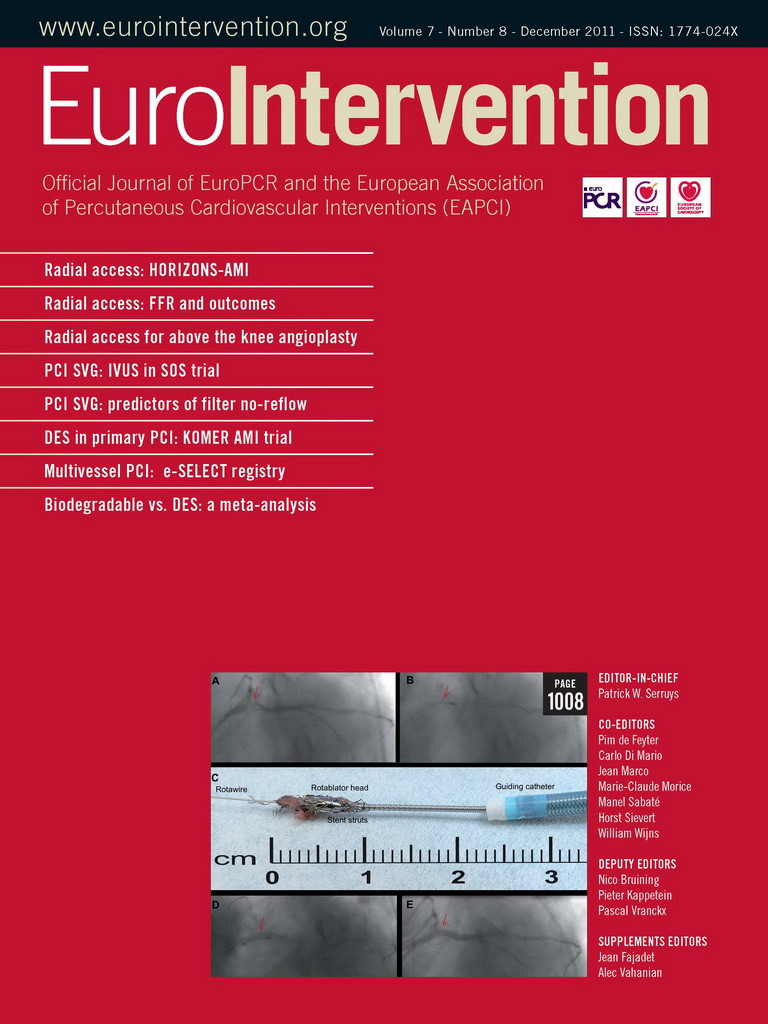The utility of aorto-coronary saphenous vein grafts (SVG) is limited by gradual attrition: around 25% of SVG present significant atherosclerotic disease at one year, and only 50% are patent at 10 years1,2. This rapid degeneration leads patients to suffer from severe anginal symptoms, despite optimal pharmacological therapy3. The treatment of patients with SVG disease remains a challenge in interventional cardiology and cardiac surgery. Percutaneous coronary intervention (PCI) is the preferred method, due to the significantly higher risks of repeated coronary artery bypass graft surgery4. However, SVG PCI also results in higher rates of acute and long-term complications when compared to native vessel PCI5. These poorer outcomes can be clarified by the physiopathology of SVG disease. Histologically, SVG atheroma is more lipid-rich and thrombus-prone than native coronary atheroma. Morphologically, SVG atherosclerosis tends to be diffuse, concentric, and friable with a poorly developed or absent fibrous cap and little evidence of calcification6. These specific characteristics and the rapidly progressive nature of SVG disease lead to the known clinical disadvantages of SVG PCI when compared to native vessels PCI:
1. a higher rate of periprocedural myocardial infarction (MI),
2. an increased incidence of restenosis and of repeated revascularisations, and
3. a faster progression of moderate “non-significant” SVG lesions.
The main reason for the higher rate of periprocedural MI is the embolisation of atherothrombotic debris into the native coronary circulation, which results in reduced antegrade flow (“no-reflow” phenomenon). Effective mechanical strategies to reduce distal embolisation include both proximal and distal embolic protection devices (EPD). All types of EPD have been proven effective and substantially similar in reducing the risk of periprocedural MI7. Among distal EPD, filters have gained widespread adoption due to their ease of use. Further understanding of specific phenomena occurring with the use of these devices is thus needed. In the current issue of EuroIntervention, Porto et al report an interesting analysis of the occurrence of the filter no reflow (FNR) phenomenon in 50 patients undergoing SVG PCI with filter EPD8. The FNR is a transient impairment of blood flow due to debris filling the filter just after SVG stenting and before filter retrieval. The authors should be acknowledged for the fact that after being the first to describe this phenomenon9, they provide additional scientific content to their field of research. Indeed, in the current work they describe the incidence of the phenomenon, around one third of their procedures; the major predictor of the phenomenon, the degeneration score; and the consequences of the phenomenon, a higher incidence of periprocedural MI as assessed by postprocedural troponin rise. While the major message of the study, besides the description of the FNR phenomenon, remains to use routinely EPD during SVG PCI, the major limitation of the study is the lack of assessment of periprocedural MI also with other markers of myocardial damage. Indeed the 36% periprocedural MI rate reported in the current study is extremely high as compared to the literature, but it is most probably justified by the use of the very specific troponin as marker of myocardial damage. However, post SVG PCI troponin seems to have no or limited impact on long-term outcomes10, while the more investigated creatine kinase-MB has been clearly linked to an increase in long-term mortality11. Another discussion point relates to the treatment of FNR once it occurred. The authors provide several patho-genetic explanations, but no potential solutions. We suggest a possible role of manual aspiration thrombectomy inside the filter that has determined FNR, thus after PCI but before final filter retrieval. This has the potential to remove directly at least some debris from the filter and to avoid its protrusion out of the filter during retrieval manoeuvres, thus limiting its embolisation downstream in the coronary circulation.
Concerning the other two disadvantages of PCI in SVG versus native arteries (higher restenosis and faster progression of non-significant lesions), the appearance of drug-eluting stents (DES) on the market seemed a possible panacea. Three randomised trials of DES versus bare metal stents (BMS) in SVG (the “Reduction of Restenosis In Saphenous vein grafts with Cypher sirolimus-eluting stent” [RRISC], the “Stenting Of Saphenous vein grafts” [SOS] and the “Is drug-eluting-Stenting Associated with improved Results in Coronary Artery Bypass Grafts?” [ISAR-CABG] trials) confirmed the benefits of DES in SVG with significant mid-term reduction in restenosis and revascularisation rates12-14. In the current issue of EuroIntervention, Jeroudi at al report the intravascular ultrasound findings of the SOS trial, showing a significant reduction in neointimal hyperplasia growth with paclitaxel DES as compared to BMS at 1 year follow up15. These findings confirm at an “intravascular” level the angiographic results of the SOS trial13, and are also in close agreement with the intravascular ultrasound findings of the RRISC trial16, in which a sirolimus DES was used instead of a paclitaxel DES. Interestingly, in the SOS trial, DES malapposition was rare and mainly localised at the stent edges, as also found in the RRISC trial. This substantial lack of malapposition in the body of the stent confirms the potential benefits of a stent implantation policy based on a matched stent-to-artery ratio and high-pressure stent deployment with daring use of postdilatation. However, the current study does not help solving the major caveat of DES in SVG, i.e., the long-term results, which remain poorly tested and understood. The only long-term published data of a randomised study are coming from the RRISC trial and they show a worrisome increased mortality after DES versus BMS17. Moreover, also the long term restenosis benefits of DES over BMS remain uncertain, as provided in several registries18.
In conclusion, the two studies presented in the current issue of EuroIntervention confirm the need to systematically use EPD during SVG PCI and corroborate the short term benefits of DES in SVG. The more things change, the more they stay the same…
Conflict of interest statement
The authors have no conflicts of interest to declare.
References

